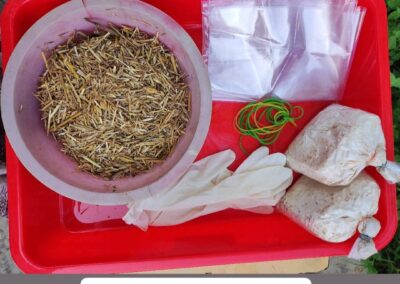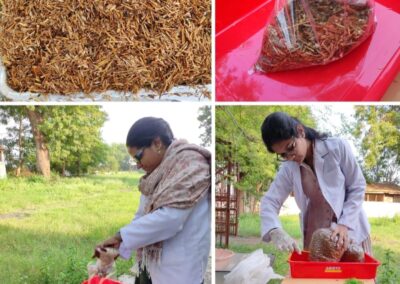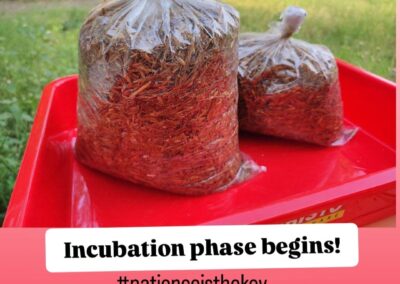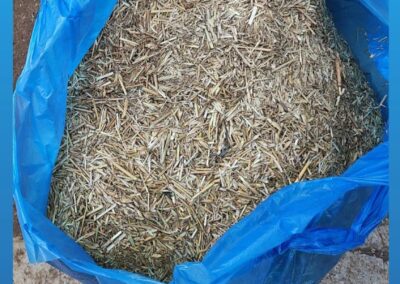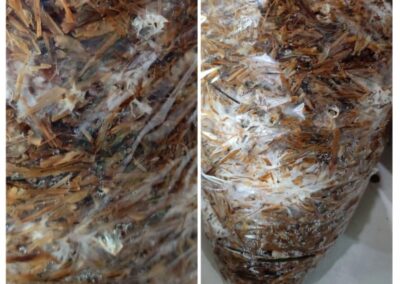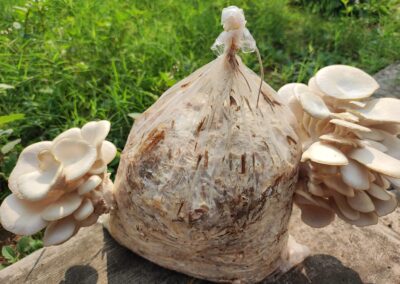Introduction:
The Botany Department at SGJQ College initiated a small-scale experiment on Oyster Mushroom (Pleurotus ostreatus) cultivation. This experiment is currently in progress, designed to help us better understand the practical challenges of mushroom cultivation before launching the Certificate Course on Mushroom Cultivation.
Objectives:
- To gain hands-on experience with the cultivation process of oyster mushrooms.
- To identify and troubleshoot potential challenges such as contamination, substrate management, and environmental control.
Benefits of Oyster Mushroom Cultivation:
- Sustainability: It promotes the use of agricultural waste (paddy straw) and offers an eco-friendly source of nutrition.
- Low Cost: Oyster mushrooms can be cultivated with minimal investment in equipment and infrastructure.
- Nutritional Value: High in protein, vitamins, and minerals, making them a healthy addition to diets.
- Commercial Potential: Mushroom farming provides opportunities for income generation and entrepreneurship, particularly in rural areas.
Essentials:
Mushroom Species used: Oyster Mushroom (Pleurotus ostreatus).
Materials required:
- PP Bags (1 kg capacity): Containing substrate and mushroom spawn.
- Paddy Straw: Substrate for mushroom growth.
- Oyster Mushroom Spawn: High-quality spawn used for inoculation.
- Water: For substrate preparation and humidity maintenance.
- Rubber bands
Procedure So Far:
Substrate Preparation:
- Paddy Straw is chopped into small pieces (2-3 cm).
- The straw is soaked in water for 12-16 hours, then drained to remove excess water.
- The soaked straw is sterilized by steaming or boiling to eliminate contaminants treated with formalin.
Filling of PP Bags:
- The prepared and sterilized paddy straw is packed into PP bags.
- Layers of straw are alternated with layers of oyster mushroom spawn to ensure even distribution of the mycelium.
- Holes are punched in the bags for aeration and to allow the fruiting bodies to emerge.
Incubation:
- The bags are placed in a dark, humid room at a temperature of 20-25°C for 2-3 weeks.
- Humidity levels have been carefully maintained at 80-90% using humidifiers.
- During this period, the mycelium spreads throughout the substrate, colonizing it entirely.
- Daily monitoring of the mycelium growth, temperature, and moisture levels is ongoing.
Monitoring the Growth:
- Regular checks to monitor the progress. Ensuring the temperature and humidity are just right for optimal growth.
Fruiting:
- Once the substrate is fully colonized, the bags are moved to an area with indirect light.
- Humidity is maintained at 80-90%, and the temperature is kept between 18-22°C.
- Small mushroom “pins” begin to form within a week.
- The mushrooms grow rapidly and can be harvested 4-6 days after pinning.
Challenges Encountered During The Experiment:
- Unfavorable Weather: The external weather has been unpredictable, with sunny days, heavy rains, and dew at night, causing fluctuations in humidity and temperature levels. These changing conditions make it difficult to maintain a stable environment for optimal mushroom growth.
- Temperature Fluctuations: We have been managing higher daytime temperatures (30-32°C), also the weather was not stable which may be slowing down the appearance of pin heads.
- Delay in Fruiting: As pin heads haven’t appeared after 8 days of incubation, we tried continue to adjust conditions to optimize growth.
Conclusion:
The successful completion of the first phase of our mushroom cultivation experiment marks a significant achievement in understanding the cultivation process. From substrate preparation to fruiting, each step provided valuable insights into the optimal conditions required for growth. The hands-on experience not only validated our methods but also highlighted key challenges and improvements needed for future cultivation.
Encouraged by these results, we have now focused on a more detailed analysis of yield
optimization, environmental factors, and sustainability. This next phase will allow us to refine our techniques and enhance the overall learning experience for future participants in the mushroom cultivation course.
Through this project, we aim to build a strong foundation for skill-based learning and practical application of the subject.
Thank you
Regards
Department of Botany

